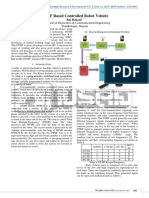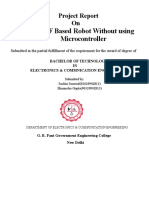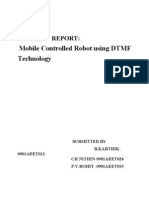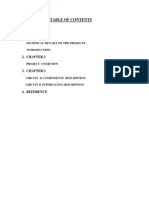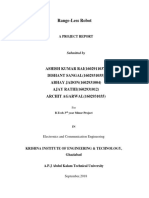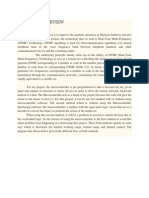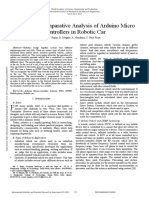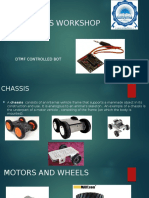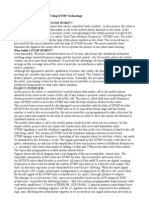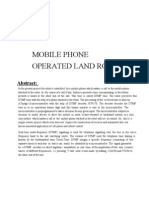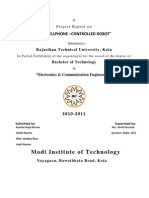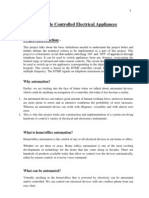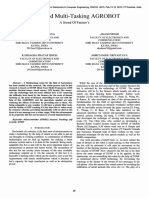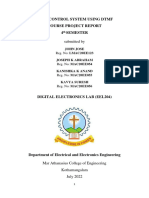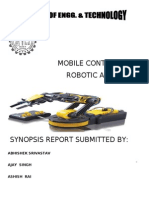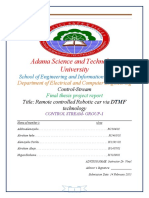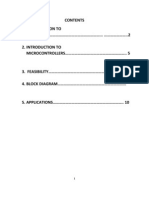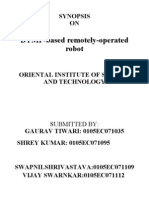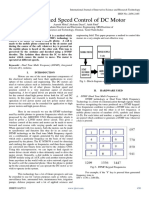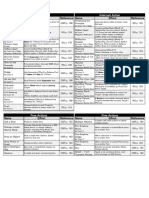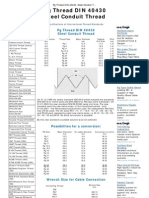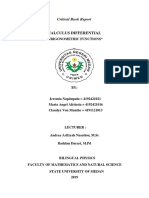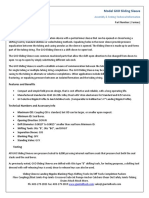ASIAN JOURNAL OF ENGINEERING, SCIENCES & TECHNOLOGY, VOL.
5, ISSUE 1 MARCH 2015
Design and Implementation of a DTMF Based Pick
and Place Robotic Arm
Muhammad Hassan and Mohtashim Baqar
Abstract—In recent times, developments in field of communi- control. Nonetheless, these constraints may be minimized by
cation and robotics has progressed with leaps and bounds. In utilizing the wireless innovations as a part of the electro-
addition, the blend of both disciplines has contributed heavily mechanical arm [5]–[7]. Further, doing so would add further
in making human life easier and better. So in this work while
making use of both the aforementioned technologies, a procedure more to the applications, strength and usability of the arm. In
for design and implementation of a mobile operated mechanical this work, DTMF has been used for operating the mechanical
arm is proposed, that is, the proposed arm will be operated via arm wirelessly over GSM [8]. Moreover, dual tone multiple
a cellular device that connects with the receiver mounted on the frequency (DTMF) signalling has been utilized for telecom
robotic arm. Moreover, over the duration of a call, if any key is motioning over simple telephony lines. The said is achieved
pressed from the cellular device than an indicator indistinct to the
key pressed is noticed at the receiver side. This tone represents while using the voice recurrence bands among telephonic
superimposition of two distinct frequencies and referred to as sets and different specialized gadgets. Further, the variants
DTMF (dual tone multi-frequency). Further, the mechanical arm of DTMF utilized for telephone tone calling are renowned
is handled via the DTMF tone. Also, the acquired tone at the and a term Touch-Tone is used to represent the process. Also,
receiver is taken into a micro-controller (ATMEGA16) using it has been standardized by ITU-T as recommendation Q.23.
the DTMF decipher module i.e. MT8870. Further, the decipher
module unwinds the DTMF signal into its corresponding two bit It is also referred to as MF4 in the Great Britain. Further,
representation and then the matched number is transmitted to the other multi-recurrence frameworks are also available utilizing
micro-controller. The micro-controller is programmed to take an the in-band signalling for different control purposes. Also, in
action based on the decoded value. Further, the micro-controller early 80’s, DTMF tones were likewise used by high quality
forwards control signals to the motor driver unit to move the TV telecasters to demonstrate the starting and halting times of
arm in forward/backward or multi-directional course. Lastly, the
mechanical arm is capable of picking and placing objects while station breaks.
being controlled wirelessly over GSM (Global System for Mobile Dual tone multiple frequency [9] has been the foundation of
Communications). tone of voice articulation management. Existing day telephonic
Index Terms—DTMF (dual tone multi frequency), DOF (De- connections make use of DTMF in order to dial volumes,
gree of Freedom), micro-controller, end effectors, kinematics. configure telephone trades (switchboards) coming from distant
control destinations and so forth.
Figure 1 illustrates dual tone multiple frequency (DTMF)
I. I NTRODUCTION
out map in form of a 4 × 4-array keypad. It gives an illus-
Robotics has been an area which has seen a lot of growth tration of the dual-tone frequency combinations generated on
and development in last 15 years [1]. Today, a big part of respective key presses on the keypad.
resources i.e. man power or money etc., allocated for research
have been utilized for development in the said discipline as
it holds a lot of applications in both commercial and military
settings [2]–[4]. Recently, a lot of the developments have been
driven by the motivation of it to be used for the betterment
of the society and to reduce human effort or workload. Robot
is an electro-mechanical machine and an automated electro-
mechanical vehicle can help humans to operate at places where
physical presence is difficult or impossible because of the
circumstances i.e. space or place set on fire etc. In this a
work a procedure for the implementation of DTMF operated
robotic arm is proposed for picking and placing of objects.
Further, the earlier customary remote controlled arms have
constraints, such as, weak human interface, circuit weaknesses,
conducive environment for remote operation and restricted
Muhammad Hassan was with the Department of Telecommunica-
tion Engineering, IQRA University (Main Campus), Karachi (e-mail:
hasan.ovais@gmail.com). Fig. 1: Dual Tone Multiple Frequency Map (DTMF)
Mohtashim Baqar is with the Faculty of Engineering, Sciences and
Technology, IQRA University (Main Campus), Karachi, Pakistan (e-mail:
mohtashim@iqra.edu.pk). Further, A, B, C and D keys are not usually utilized and
8
�ASIAN JOURNAL OF ENGINEERING, SCIENCES & TECHNOLOGY, VOL.5, ISSUE 1 MARCH 2015
conventional keypads don’t have these keys. However, these
keys were earlier used a lot in land line telephone and fax
systems to configure with the local exchanges or to perform
specialized tasks. When a key is pressed on the keypad,
a tone, combination of two superimposed frequencies, is
generated and send to the local exchange for decoding. These
combinations of frequencies were utilized to issue instructions
and operate the electro-mechanical arm wirelessly.
II. C ONNECTION L AYOUT
Fundamental building blocks of the electro-mechanical arm
are the DTMF decoder, micro-controller, motor driver circuity
and power supply unit. A MT8870 DTMF decoder has been
utilized in this work. Further, different versions of MT8870
are available utilizing the advanced digital counting techniques
Fig. 3: DTMF Decoder - MT8990
to detect and decode all the 16 DTMF tone sets into their
respective 4-bit codes. Moreover, there wasn’t any need of a
preprocessing or pre-filtering circuit for the removal artefacts
from the generated dual-tone signal. This is due to the built-in
noise rejection filter in the signal generating source, mitigating
the adverse effects of any unwanted frequency component.
Figure 2 illustrates the circuit diagram for the DTMF decoder.
Fig. 4: DTMF - Output Map
Fig. 2: Receiver - DTMF Interfacing Circuit
B. ATMEGA-32 Micro-controller
The fundamental blocks of this automated mechanical arm In this work, an ATMEL micro-controller has been used.
are as follows, The ATMEL AVR module has 32 registers. Further, the said 32
1) DTMF Decoder registers are connected with the arithmetic logic unit (ALU),
2) ATMEGA32 Micro-controller letting two different registers to be worked on a single clock
3) Motor Driver cycle. The design is more effective while accomplishing cycles
4) Regulated Power Supply up to ten times quicker than true CISC micro-controllers.
Portion below gives a brief overview of the fundamental
modules of the complete model. C. L293 Motor Driver
For motor driving, L293 motor driver has been used [10].
A. DTMF Decoder L293 is an incorporated circuit motor driver that could be
In this work, a MT8870 arrangement DTMF decipher utilized for multi and bidirectional navigation of two motor.
is utilized. The MT8870d/ MT8870d-1 is an accomplished Moreover, it’s load driving limit is till 600 m-amp, however,
DTMF collector having the advanced decipher capacity. The it can only handle a less amount of current compared to it’s
channel segment uses twisted capacitor systems for higher and maximum value due to excessive rise in temperature during
lower gathering channels and the decoder utilizes advanced regular operations.
checking procedures to identify and translates every one of Further, L293 is available normally in a 16-pin package,
the 16 DTMF tone sets into a 4-bit code. Different varieties a dual-in-line incorporated circuit bundle. Moreover, there
of MT8870 arrangements utilize the computerized matching is another variant of it with the name, L293D. The ”D”
systems to discover and discriminate all the 16 DTMF tone adaptation is picked in the greater part of the cases as it has
sets into a 4-bit code. Figure 4 and 3 illustrates the DTMF implicit fly back diodes that minimize the inductive voltage
decoder and output map of the DTMF decoder, respectively. spikes.
9
�ASIAN JOURNAL OF ENGINEERING, SCIENCES & TECHNOLOGY, VOL.5, ISSUE 1 MARCH 2015
Further, two DC motors and two servo motors have been of kinematic equations involving robotics while the desired
used in this implementation to drive the base on which the arm position of the end effectors is known [12].
has been mounted and to move the arm, respectively. Figure
5 illustrate circuit diagram of the motor driving unit. IV. MATHEMATICAL ANALYSIS
There could be many desirable outcomes if only the math-
ematical values of the end effectors are given as the input. So
for avoiding repetition, one more gripper angle is taken with
respect to the horizontal as input.
These are supposed as the input to a robotic arm:
1) The x, y, z coordinate of the end effectors.
2) The following values should be known: base length (1),
shoulder length (2), arm length (3), gripper length (4)
3) Gripper Angle (g)
4) Radial Length (r)
For ease, the estimations of 3-D inverse kinematics are
changed into 2-D form. For this purpose, two planes are being
examined to be rectilinear with each other: z-plane and x, y-
Fig. 5: Motor Driving Circuitry plane in horizontal as shown in figure 7.
D. Power Supply
A switch-controlled power supply has been used in this
work [11]. It is one in which the produced voltage is constantly
balanced as per the necessities. Further, the operating voltage
range of the power supply used in this work is ±36 volts with
an available current of 12amp..
Fig. 7: XYZ Plane
III. R EVERSE K INEMATICS
Kinematics is a field describing motion of an object or
Moreover, mathematical outcomes in the x, y plane use
structure. It has two main parts namely, forward kinematics
coordinates x and y.
and reverse kinematics.
Further, the position of the z-plan is determined with the
Forward kinematics uses kinematic equations of a robot
help of the rotating motor as it goes across the coordinates (0,
to find the position of end-effectors from joints inside the
0, 0) and the radial distance (r) is given at (x, y, 0) coordinates.
structure.
But if one is willing to familiarize that how the upper joint
framework would keep on motion when it is obligatory that V. CALCULATED TORQUE
the end effectors should move in the direction of its mean Torque is the measure of how many forces are acting on
position. In that case direct estimations are worked out in the an object which in result make that object to rotate. It is
mechanical framework so that the connecting angle can be denoted by T. Torque (T) is termed as a rotating ”force” and
calculated as the alterations are done in the end effectors. is estimated using the following equation.
Figure 6 illustrates structure manipulation via forward and
T =F ∗L (1)
inverse kinematics.
where, T represents torque, F represents calculated force and
L denotes the length from the pivot point. Also, force is the
acceleration of an object due to gravity (g = 9.81 m/s2 )
multiplied by its mass.
F =M ∗g (2)
where, ’M’ denotes mass and ’g’ denotes gravity.
In addition, force (F) is also considered to be equal to an
object’s weight(W). Mathematically,
W =M ∗g (3)
Fig. 6: Structure Manipulation (a) Forward (b) Inverse
Therefore, the torque needed to grab a mass at a given
displacement from a pivotal point is given by,
Therefore, it can be said that the notion of reverse kine-
matics employs joint parameter estimation with the help T = (M ∗ g) ∗ L (4)
10
�ASIAN JOURNAL OF ENGINEERING, SCIENCES & TECHNOLOGY, VOL.5, ISSUE 1 MARCH 2015
Where, the length ’L’, is the perpendicular length from a pivot VIII. ACKNOWLEDGEMENT
point to the force. Similarly, length can also be found by doing The authors would like to acknowledge the Faculty of En-
a torque balance about a point. Mathematically, gineering, Sciences and Technology (FEST), IQRA University
X
T = 0 = F ∗ LT (5) for their persistent support and encouragement throughout the
course of the project.
Hence, replacing the force (F) with mass and gravity (m*g),
we can find out the same equation above. This is the more IX. C ONCLUSION
accurate way to find out the torque by using the torque balance. In this implementation, an electro-mechanical arm con-
Figure 8 illustrates torque balancing. Mathematically, trolled via cellular phone has been developed that makes a
M ∗ g ∗ L = TA (6) call to the cell phone attached to the arm. During the duration
of the call, if any key is pushed, a tone mapped to the key
pushed is acquired at the receiver side. This remotely operated
electro-mechanical arm eliminates the constraint of a cabled
medium via use of wireless technologies, that is, GSM and
DTMF in this case.
Further, work can still be done to enhance the strength and
capacity of this framework. Cell phone that makes a call to
cellular phone attached to the base of the mechanical arm
provides remote access and henceforth, this does not need the
development of receiving and transmitting units and also it
is free from the issues related to RF communication and it’s
reachability. Moreover, this model could be extremely useful
in events of data collection from areas of human outreach,
Fig. 8: Torque Balance
which has been one of the prime causes of rise in research
activities in this domain.
VI. S AMPLE W ORKING
The implemented electro-mechanical arm can lift up to 10 R EFERENCES
kg of weight. Figure 9 illustrate the gripper of the robotic [1] K. Balasubramanian, R. Arunkumar, J. Jayachandran, V. Jayapal, B. A.
arm. Further, servo motors were used for strengthening and Chundatt, and J. D. Freeman, “Object recognition and obstacle avoidance
robot,” in 2009 Chinese Control and Decision Conference. IEEE, 2009,
loosening of grip of the gripper as well as for the movement pp. 3002–3006.
of the arm whereas DC gear motors were used to move the [2] E. M. Wong, “A phone-based remote controller for home and office
arm in forward and backward direction. With key presses using automation,” IEEE Transactions on Consumer Electronics, vol. 40, no. 1,
pp. 28–34, 1994.
the key pad of any cellular device one can operate the robotic [3] I. Coskun and H. Ardam, “A remote controller for home and office
arm subject to that the cellular device is connected to the one appliances by telephone,” IEEE Transactions on Consumer Electronics,
mounted on the robotic arm. vol. 44, no. 4, pp. 1291–1297, 1998.
[4] J. N. Moutinho, F. D. Mesquita, N. Martins, and R. E. Araujo,
“Progresses on the design of a surveillance system to protect forests
from fire,” in Emerging Technologies and Factory Automation, 2003.
Proceedings. ETFA’03. IEEE Conference, vol. 2. IEEE, 2003, pp. 191–
194.
[5] K. Sai and R. Sivaramakrishnan, “Design and fabrication of holonomic
motion robot using dtmf control tones,” in Control, Automation, Com-
munication and Energy Conservation, 2009. INCACEC 2009. 2009
International Conference on. IEEE, 2009, pp. 1–4.
[6] R. Sharma, K. Kumar, and S. Vig, “Dtmf based remote control system,”
in 2006 IEEE International Conference on Industrial Technology, 2006.
[7] A. Mustafa, H. Jameel, M. Baqar, R. A. Khan, Z. M. Yaqoob, Z. Rahim,
and S. Khan, “Vehicle intrusion and theft control system using gsm and
gps.” Asian Journal of Engineering, Sciences & Technology, vol. 2, no. 2,
Fig. 9: Torque Balance 2012.
[8] G. Aranguren, L. A. Nozal, A. Blazquez, and J. Arias, “Remote control
of sensors and actuators by gsm,” in IECON 02 [Industrial Electronics
VII. APPLICATIONS AND FUTURE SCOPE Society, IEEE 2002 28th Annual Conference of the], vol. 3. IEEE,
2002, pp. 2306–2310.
As already mentioned that robotics have greater application [9] K. G. Gulledge, “Automated quality assessment system for cellular
in military and rather in all walks of life. Examples being networks by using dtmf signals,” Jul. 1 1997, uS Patent 5,644,623.
[10] H. Singh and S. M. Sharma, “Some novel µp-based configurations
the unmanned aerial vehicles, capturing an militants, spying for controlling remotely located stepper motors as actuators of control
and rescuing people. Quite a few nations are contemplating to valves,” IEEE transactions on industrial electronics, vol. 38, no. 4, pp.
make utilization of these vehicles in case of any catastrophes 283–287, 1991.
[11] G. R. Smallhorn, “In-seat power supply floor module,” Dec. 5 2006, uS
& natural calamity. Also, these automated vehicles will also Patent 7,143,978.
be helpful to reach and access places where human reach and [12] L. Sciavicco and B. Siciliano, Modeling and control of robot manipu-
presence is not possible under the circumstances. lators. McGraw-Hill New York, 1996, vol. 8, no. 0.
11
�ASIAN JOURNAL OF ENGINEERING, SCIENCES & TECHNOLOGY, VOL.5, ISSUE 1 MARCH 2015
Muhammad Hassan received the B.E degree in Telecommunication from 2011 and 2016, respectively. Since 2012, he has been a Lecturer in Faculty
IQRA University (Main Campus), Karachi 2013, respectively. of Engineering, Sciences and Technology, IQRA University (Main Campus),
Karachi. His research interests are multi-variate signal processing and pattern
Mohtashim Baqar received the B.E and M.S degrees in Telecommunication recognition.
and Electrical Engineering from IQRA University (Main Campus), Karachi
and National University of Sciences and Technology, Islamabad, Pakistan, in
12



